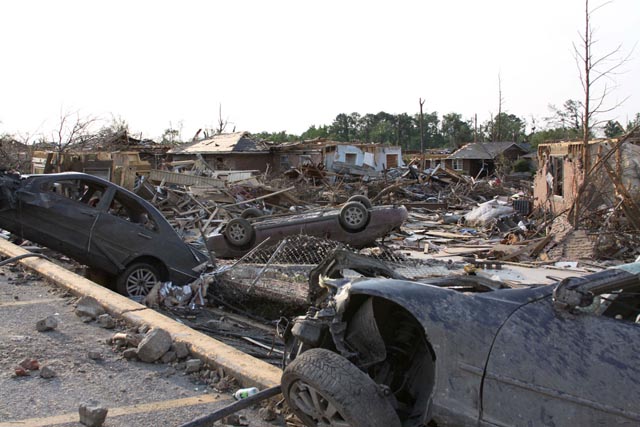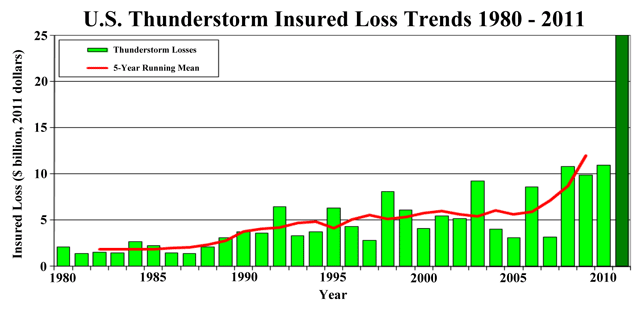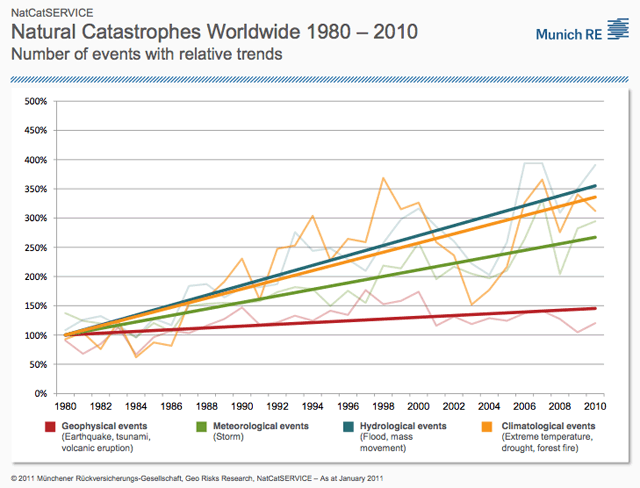 Damage Losses And Climate ChangeBy Jeff Masters, www.wunderground.com January 03, 2012 During 2011, a series of violent tornado outbreaks hit the Plains and Southeast U.S., bringing an astonishing six billion-dollar disasters in a three-month period. The epic tornado onslaught killed 552 people and brought three of the five largest tornado outbreaks on record in a six-week period, including the largest and most expensive tornado outbreak in U.S. history--the April 25 - 28 Super Outbreak, which did $10.2 billion dollars in damage. Insured losses due to thunderstorms and tornadoes in the U.S. were at least $25 billion in 2011, more than double the previous record set in 2010. Damages from thunderstorms and tornadoes since 1980 have shown a clear increase since 1980 (Figure 2.) Disaster losses world-wide from weather-related natural disasters have also shown a significant increase in recent years, as has the number of these disasters. But how much of this is due to a change in the climate, and how much might be due to increases in population, wealth, and other factors?
 Figure 1. Damage in Tuscaloosa, Alabama after the April 27, 2011 EF-4 tornado. Image credit: NOAA. Not enough evidence to judge if climate change is affecting tornadoes As I discussed last week in my post, 2011: Year of the Tornado, as far as we can tell, the number of damaging tornadoes has not increased in recent years, though the quality of the data set is to poor to know for sure. This is largely due to the fact that we never directly measure a tornado's winds--a tornado has to run over a building before we can make an EF-scale strength estimate, based on the damage. As tornado researcher Chuck Doswell said in a 2007 paper, "I see no near-term solution to the problem of detecting detailed spatial and temporal trends in the occurrence of tornadoes by using the observed data in its current form or in any form likely to evolve in the near future." My 2008 post, Are tornadoes getting stronger and more frequent?, discussed how a better way to assess how climate change may be affecting tornadoes is to look at how the large-scale environmental conditions favorable for tornado formation have changed through time. The most important ingredients for tornado formation are usually high atmospheric instability (as measured by the Convective Available Potential Energy, or CAPE), and high amounts of wind shear between the surface and 6 km altitude. Not enough work has been done on the subject to judge whether or not climate change is affecting severe thunderstorms and tornadoes, though.  Figure 2. Insured losses due to thunderstorms and tornadoes in the U.S. in 2011 dollars. Data taken from Property Claims Service MR NatCatSERVICE. Image credit: Munich Re. At a talk given last month at the American Geophysical Union meeting in San Francisco, Mark Bove of Munich Re insurance company examined trends in both damages and number of natural disasters since 1980. These numbers have shown significant increases since 1980. After we take out the increase in disasters reported due to an increasing population, greater wealth, and more advanced communications, is there a trend due to climate change? One way to check is to compare natural disasters due to geophysical events--earthquakes, tsunamis, and volcanic eruptions--to weather-related disasters. Geophysical disasters should remain relatively constant in number in a changing climate (unless sea level rise is occurring so rapidly that it is causing significant changes in stress on earthquake faults, something that is theoretically possible, but has not yet been observed.) If we then look at trends in the number of geophysical disasters versus weather-related disasters reported, it should give us an idea of how much of the recent increase in weather-related disasters may be due to climate change. Between 1980 and 2010, geophysical disasters increased by about a factor of 1.5, while weather-related disasters increased by a factor of 2.7 to 3.5 (Figure 3.) Bove stated that he thought weather-related disasters were likely subject to a higher increase in reporting rate than geophysical disasters, but not enough to account for the huge difference. Climate change was the likely reason for a large portion of the increase in weather-related disasters in recent years, he argued. His talk concluded, "there is quite some probability that natural catastrophe losses are driven already by human-caused climate change."  Figure 3. The number of natural disasters reported has increased markedly worldwide since 1980, particularly for weather-related disasters. Image credit: Munich Re. However, this conclusion is controversial. A 2010 paper in the Bulletin of the American Meteorological Society by Netherlands researcher Laurens Bouwer titled, "Have disaster losses increased due to anthropogenic climate change?", looked at 22 disaster loss studies world-wide, published between 2011 and 2010. All of the studies showed an increase in damages from weather-related disasters in recent decades. Fourteen of the 22 studies concluded that there were no trends in damage after correcting for increases in wealth and population, while eight of the studies did find upward trends even after such corrections, bringing up the question whether or not climate change could be responsible for the increased disaster losses. However, Bouwer found that "studies that did find increases after normalization did not fully correct for wealth and population increases, or they identified other sources of exposure increases or vulnerability changes or changing environmental conditions." In all 22 studies, increases in wealth and population were the "most important drivers for growing disaster losses." He concluded that human-caused climate change "so far has not had a significant impact on losses from natural disasters." So, looking at disasters losses to make an argument that climate change is affecting our weather is difficult, due to the rarity of extreme events, and the changes in wealth and population that also affect disaster losses. We are better off looking at how the atmosphere, oceans, and glaciers are changing to find evidence of climate change. References Bouwer, L, 2010, "Have disaster losses increased due to anthropogenic climate change?", BAMS, January 2011, DOI:10.1175/2010BAMS3092.1 Doswell, C.A., 2007, "Small Sample Size and Data Quality Issues Illustrated Using Tornado Occurrence Data", E-Journal of Severe Storms Meteorology Vol 2, No. 5 (2007). Del Genio, A.D., M-S Yao, and J. Jonas, 2007, Will moist convection be stronger in a warmer climate?, Geophysical Research Letters, 34, L16703, doi: 10.1029/2007GL030525. Marsh, P.T., H.E. Brooks, and D.J. Karoly, 2007, Assessment of the severe weather environment in North America simulated by a global climate model, Atmospheric Science Letters, 8, 100-106, doi: 10.1002/asl.159. Riemann-Campe, K., Fraedrich, K., and F. Lunkeit, 2009, Global climatology of Convective Available Potential Energy (CAPE) and Convective Inhibition (CIN) in ERA-40 reanalysis, Atmospheric Research Volume 93, Issues 1-3, July 2009, Pages 534-545, 4th European Conference on Severe Storms. Trapp, R.J., N.S. Diffenbaugh, H.E. Brooks, M.E. Baldwin, E.D. Robinson, and J.S. Pal, 2007, Severe thunderstorm environment frequency during the 21st century caused by anthropogenically enhanced global radiative forcing, PNAS 104 no. 50, 19719-19723, Dec. 11, 2007. Jeff Masters Categories:Climate Change Extreme Weather
|
Email this page to a friend
If you speak another language fluently and you liked this page, make
a contribution by translating
it! For additional translations check out FreeTranslation.com
(Voor vertaling van Engels tot Nederlands)
(For oversettelse fra Engelsk til Norsk)
(Для дополнительных
переводов проверяют
FreeTranslation.com )

